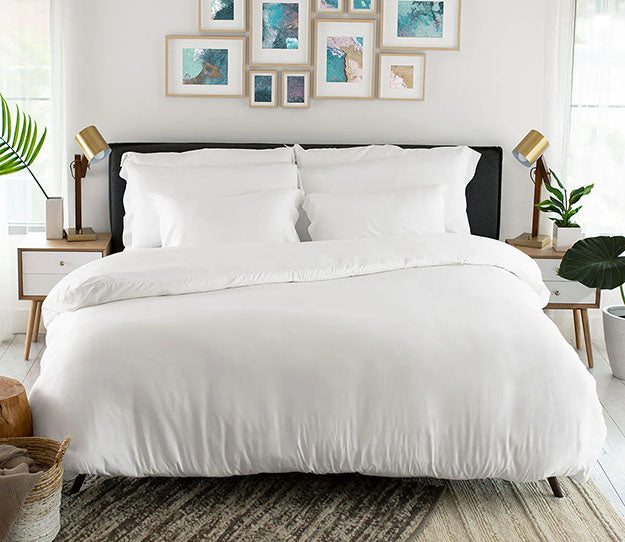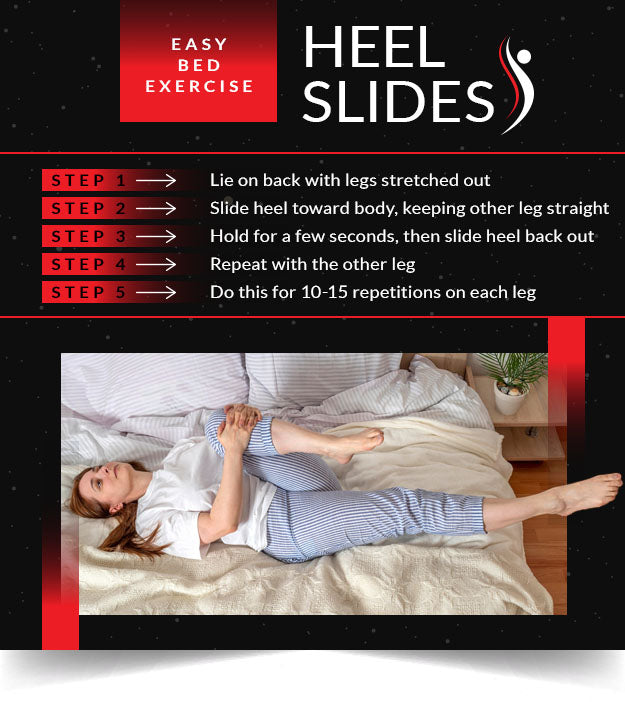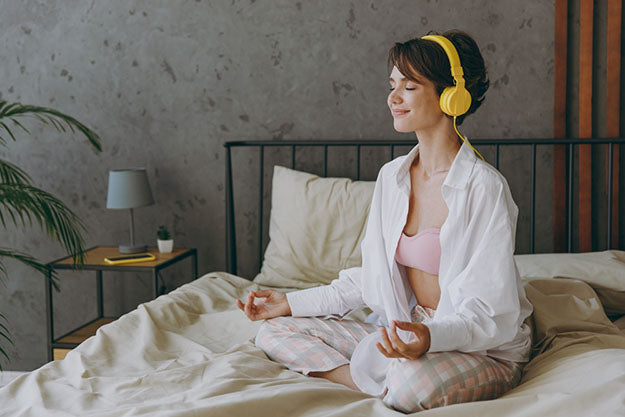
Did you know that staying active and maintaining mobility is essential for our overall well-being? It’s true. Regular exercise helps us stay fit and feel great physically and mentally. Now, you might wonder how to fit more exercise into your busy day. Well, we’ve got some fantastic news for you. Incorporating bedtime exercises into your nightly routine is a simple and effective way to increase mobility and range of motion, improve sleep quality and help you unwind after a long day.
Even better, these exercises are not only perfect for those with overloaded schedules, but they’re also suitable for people with limited mobility or other health issues who can't do more strenuous exercise. They provide a low-impact, accessible way to stay active and maintain muscle strength without putting too much strain on your body. In addition to diving into these easy-to-follow exercises, we’ll ensure you’re set up for success. We’ll touch on the best mattresses and pillows to enhance your exercise experience, ensuring you can enjoy both comfort and support.
Is It Bad to Exercise Before Bed?
In the past, some people worried that bed exercises would keep them awake at night. Exercise increases your heart rate and blood flow, which theoretically makes it harder to fall asleep. However, studies have shown that exercising before bed doesn't keep you from getting enough sleep as long as you engage in moderate activity.
When you engage in high-intensity exercises, such as jumping jacks and clapping push-ups, the stimulation may keep you awake and lower your sleep quality. Sore, aching muscles contribute to poor sleep hygiene. Worse, if you injure yourself, you'll have to stave off your bedtime for medical care.
Instead of working out vigorously before bed, opt for moderate-intensity exercises that stretch your muscles and relieve tension without overexerting yourself. These exercises wear out your body, making it easier to fall asleep. As you make exercising a regular part of your bedtime routine, your brain adjusts and starts producing melatonin accordingly. If you have kids, you could even invite the whole family to engage in mild exercise before bed.
If you're new to bedtime exercises and own an old mattress, consider replacing it with a newer, firmer model. Old mattresses tend to sag instead of keeping your frame upright. Firm mattresses are ideal for exercising because they support your body while creating a comfortable sleeping environment. Adjustable beds offer extra support, allowing you to raise your shoulders and knees. Split adjustable beds also make it easier to work out while your partner sleeps.
For pillows, seek firm materials that support your neck while you work out. Memory foam pillows contour to your body, making it easier to exercise and develop a routine. Many exercises take place on your back, so look for a back pillow that emphasizes support and comfort. Excessively soft pillows let your body sink into the mattress, so it's harder to keep in shape.
Overall, these exercises are healthy if you invest in the right equipment, listen to your body and stick to your comfort level. You can gradually push your boundaries, but straining a tendon in bed will shock you to alertness. Mild stretching sensations are normal, but stop if you experience severe pain.
Additionally, consider keeping water near your bed so that you can stay hydrated as you exercise. Avoid coffee, tea, soda and other drinks that keep you awake. Likewise, avoid loud, energetic music that makes you want to get up and dance. Instead, you could play soft music while you work out to gradually lull your mind to sleep.
9 Bed Exercises You Can Try
Ready to transform your bedtime routine? We’ve compiled a list of nine versatile exercises suitable for different fitness levels and needs. Discover how these simple yet effective movements can help improve your flexibility, strength and overall well-being, all from the comfort of your bed.
Upper Body Exercises
1) Arm Lifts
- While lying on your back, keep your arms by your sides with palms facing down.
- Slowly lift your arms toward the ceiling, keeping them straight and perpendicular to your body.
- Once your hands are overhead, hold the position for a few seconds.
- Then slowly lower your arms back to your sides.
- Keep your shoulders relaxed, and avoid arching your back or straining your neck.
Maintaining proper form during arm lifts is important to avoid injury or strain. Some common signs of doing the exercise incorrectly include arching your back, shrugging your shoulders or lifting your head off the pillow. To ensure you’re performing the exercise correctly, try it with a partner who can give you feedback. Additionally, start with a low number of repetitions and gradually increase the number over time as your strength improves. If you experience any pain or discomfort during or after the exercise, speak with your healthcare provider before continuing.

2) Seated Shoulder Circles
- Sit comfortably on the edge of your bed with feet flat and back straight.
- Extend your arms straight out in front of you, parallel to the ground.
- Make small circular motions with your shoulders while keeping shoulders relaxed and arms straight.
- Increase circle size gradually, moving arms toward the sides of the body.
- Reverse the circles’ direction, gradually decreasing size until back to small circles.
- Repeat for 30 seconds, and then rest for 30 seconds before moving on.
Seated shoulder circles are a great way to improve shoulder and upper back mobility. When done correctly, they can help reduce stiffness and pain in your upper body. Keeping your shoulders relaxed throughout the exercise and gradually increasing the circles’ size to avoid strain or injury is important. Imagine trying to push your shoulders down and try to create space between your shoulders and your ears. Remember to breathe deeply and evenly throughout the exercise and take breaks if you feel tired or uncomfortable.
Lower Body Exercises
3) Leg Lifts
- Lie on your back with your legs stretched out.
- Lift one leg up slowly as high as possible without bending your knee.
- Hold for a few seconds, and then lower your leg back down.
- Repeat with your other leg.
- Do this for 10-15 repetitions on each leg.
To perform leg lifts effectively, keeping your legs straight throughout the exercise is important. Additionally, it is crucial to lift your leg only as high as you can without feeling pain or discomfort. In case you have difficulty lifting your leg, you can try bending the knee of the leg on the ground to give yourself some leverage. By following these guidelines, you can ensure that you are performing leg lifts correctly and safely.

4) Heel Slides
- Lie on your back with your legs stretched out.
- Slowly slide one heel toward your body, keeping your other leg straight, bending at your knee as it elevates.
- Hold for a few seconds, and then slide your heel back out.
- Repeat with the other leg.
- Do this for 10-15 repetitions with each leg.
To perform heel slides, keep your movements slow and controlled. Remember not to push yourself too hard, and slide your heel in only as far as is comfortable for you. Additionally, ensure you are sliding your heel straight in and out, avoiding any sideways movements.
Core and Trunk Exercises
5) Pelvic Tilts
- Lie down on your back with your knees bent and feet flat on the bed.
- Take a deep breath and exhale while you contract your abdominal muscles to flatten your lower back against the bed.
- Bend your pelvis up slightly.
- Hold this position for a few seconds before releasing and returning to your starting position.
- Repeat this movement for 10-12 repetitions.
Keep your upper body relaxed, and avoid lifting your hips off the bed. To make this exercise more challenging, try holding the pelvic tilt longer. If you’re experiencing lower back pain, move only within a comfortable range of motion.
6) Lying Figure Four Stretch
- Lie on your back with your knees bent and feet flat on the bed.
- Cross your right ankle over your left knee, creating a figure four shape.
- Use your hands to gently pull your left knee toward your chest until you feel a stretch in your right hip and glute area.
- Hold the stretch for 15-30 seconds, and then release.
- Repeat on the other side.
While performing the lying figure four stretch, keep your head and shoulders on the bed for the best results. The exercise should result in a noticeable stretch in your hip and glute area. However, stop the exercise immediately if you feel any pain or discomfort. It is important to take deep breaths and relax while performing the stretch. With each breath’s release, you may find you can engage deeper. However, never pull or wrench your leg with force.

7) Bridging
- Lie down on your back with your knees bent and feet flat on the bed.
- Take a deep breath and exhale while you lift your hips off the bed, pushing through your heels.
- Hold this position for a few seconds before releasing and returning to your starting position.
- Repeat for 10-12 repetitions.
To effectively perform the bridging exercise, keep your feet flat on the bed and your knees in line with your hips. As you lift your hips, focus on squeezing your glutes and engaging your core muscles. Avoid pushing your hips too high or arching your back excessively. To increase the intensity of the exercise, you can try lifting one leg off the bed and holding the position for a few seconds before lowering it back down.
Stretching and Relaxation Exercises
8) Cat-Cow Stretch
- Begin on your hands and knees on the bed, with your wrists directly under your shoulders and your knees under your hips.
- As you inhale, arch your spine and lift your head and tailbone toward the ceiling.
- As you exhale, round your spine, tucking your chin to your chest and bringing your tailbone toward your knees.
- Repeat this movement, inhaling into the cow pose and exhaling into the cat pose.
- Perform 10-12 repetitions, moving slowly and smoothly with your breath.
The cat-cow stretch can be a gentle and effective way to stretch the spine and release tension. As you move through the poses, focus on the quality of your breath, inhaling deeply as you arch your spine and exhaling completely as you round it. If you experience any pain or discomfort, back off and move slowly and mindfully.

9) Child’s Pose
- Start by sitting on your heels with your knees a hip-width apart.
- Lean forward and stretch your arms out in front of you.
- Rest your forehead on the bed and breathe deeply.
- Hold this position for 30 seconds to 1 minute.
- To release the pose, slowly sit back up.
Child’s Pose is a gentle and relaxing stretch that can help alleviate stress and tension in the body. To modify the pose, you can use a pillow or folded blanket to support your knees and ankles if you experience knee or ankle pain.
If you have difficulty reaching your arms out in front of you, you can place them along your sides instead. During the stretch, take deep breaths and focus on relaxing your body and releasing tension or stress. If you’re wondering what to do when you can’t sleep, this relaxing exercise is a great option to help you zone and zen out simultaneously.

Best Mattresses for Exercises
A supportive and comfortable mattress is essential for a good night’s sleep and less joint and back pain. And if you plan to incorporate exercises into your routine, it’ll definitely impact those. A suitable mattress can make all the difference in achieving success with your bedtime exercise routine.
King Size Mattresses
If you’re looking for a spacious and functional mattress for exercises, a king-size mattress is an excellent option. With ample space to move around and stretch, you can enjoy a comfortable and supportive surface. Whether you’re practicing bridges or engaging in a relaxing child’s pose, a king-size mattress can help support your body and enhance your experience.
Tempur-Pedic Mattresses
Another great mattress option for exercising is the Tempur-Pedic mattress. Made from high-quality materials, this mattress conforms to your body’s shape, offering superior support and comfort. The Tempur-Pedic mattress is perfect for anyone who suffers from back pain, as it helps alleviate pressure on your spine. And its motion isolation capabilities will ensure stability during your exercises.
Other Mattress Options
There are plenty of other mattress options that can enhance your exercise routine. Hybrid mattresses, for example, are a popular choice for those who want the best of both worlds: the support of a spring mattress and the comfort of memory foam. Innerspring mattresses are also a great option for those who prefer a firmer surface with excellent support. Finally, latex mattresses are a good choice for anyone who wants a natural and durable mattress with pressure relief.

Best Pillows for Exercises
When exercising in bed, you need a quality pillow that supports your body, especially your head, neck and shoulders. An unsupportive pillow can cause stiffness, pain and discomfort, hindering your workout routine. Additionally, a comfortable pillow lets you relish the tranquility of your bed workout, allowing you to focus on each exercise.
Memory Foam Pillows
Memory foam pillows are fantastic for exercising because they mold to your body and provide great support. When properly positioned, a memory foam pillow can also relieve pressure on your joints, allowing you to exercise for longer periods. And since memory foam pillows are more durable than traditional pillows, you won’t have to switch to new ones as often.
Latex Pillows
Latex pillows are another great option for exercising, as they are responsive and durable, guaranteeing long-lasting support. Natural and hypoallergenic, they are also ideal for individuals with allergies or respiratory problems. Latex pillows have a notable edge over other pillows when it comes to breathability, allowing for good air circulation, which in turn promotes good health. Natural latex is also naturally dust mite and mildew resistant, meaning you can rely on it to be safe, clean and durable.
Incorporating Exercises Into Your Nightly Routine
Establishing a consistent routine can help signal your body that it’s time to wind down and prepare for sleep.
1) Start with a 10-to-15-minute routine, and try to do it at the same time each night. Avoid electronic devices and other distractions that may interfere with your sleep routine. Consider adding relaxation techniques such as deep breathing, meditation or gentle stretches to help prepare your mind and body for rest.
2) Gradually increase the number of exercises you do each night, but be mindful not to tire your body out or get your heart pumping too fast. Start with just a few exercises, and limit their duration. As you become more comfortable, gradually increase the time and number of exercises. Avoid high-intensity exercises that could interfere with your ability to fall asleep and general sleep hygiene.
3) Listen to your body and adjust your routine as needed. Everyone’s body is unique, so what works for someone else may not work for you. Pay attention to how your body responds to each exercise, and adjust your routine accordingly. If an exercise feels uncomfortable, consult your doctor before continuing.
4) Combine exercises with other relaxation techniques for better sleep. For example, deep breathing exercises, guided meditation, visualization, stretches and aromatherapy with essential oils can all complement your exercise routine. The key is to create a routine that works for you and promotes a good night’s sleep.

Additional Tips for Success
There are a few things to remember when it comes to achieving success with these exercises.
- First, creating a comfortable and conducive environment for your workouts is important. Ensure you have enough space to move around, and invest in comfortable bedding and pillows.
- Second, before beginning any exercise program, it’s always a good idea to consult a healthcare professional to ensure it is safe and appropriate.
- Last, don’t forget to keep track of your progress and stay motivated! Whether tracking your workouts in a journal or rewarding yourself for achieving milestones, setting goals and staying positive can make all the difference in reaching your fitness goals.
By following these additional tips, you’ll be on your way to success with your exercises in no time.
Wrapping Up
By incorporating simple exercises into your nightly routine, you can work on mobility and range of motion, improve your sleep quality and maintain muscle strength. Establishing a consistent routine that works for you and combining exercise with other relaxation techniques can lead to a peaceful and restful night’s sleep.
Remember to listen to your body, and consult with a healthcare professional before beginning any exercise program. With a comfortable and supportive bedroom environment, a positive mindset and the right mattress and pillows, success with bed exercises is within reach and can help you achieve your goals.
Image Credits
NeelRong/Shutterstock.com
www_logo_expert/Shutterstock.com
sini4ka/Shutterstock.com
TSViPhoto/Shutterstock.com
UfaBizPhoto/Shutterstock.com
ViDI Studio/Shutterstock.com